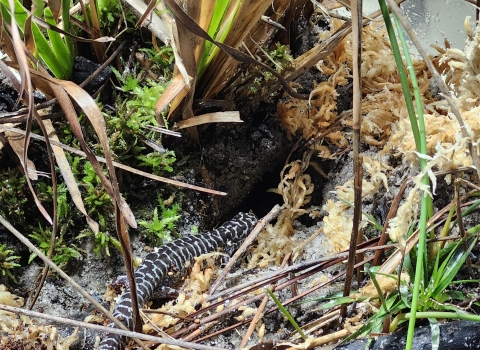A team of agency and university specialists and an extensive group of stakeholders, have drafted a recovery plan for the threatened Chiricahua leopard frog. The U.S. Fish and Wildlife Service is seeking public comment on the draft plan and extending a request for citizen assistance in the frog's recovery. The Chiricahua leopard frog was listed as a threatened species in 2002 with a unique special rule encouraging cattlemen to continue their regular management of livestock tanks that harbor leopard frogs.
"The Chiricahua leopard frog is such a unique part of the Southwest's limited aquatic resources that it has recruited a diverse array of supporters," said Steve Spangle, Arizona Ecological Services Field Supervisor. Even before its listing, State and Federal agencies, area ranchers, high school students, and organizations invested much time and energy in the shared goal of conservation and restoration of Chiricahua leopard frog habitat and populations. "We were able to parlay this interest into stakeholder groups that assisted biologists in drafting a recovery plan that is grounded in the logistical realities of on-the-ground species recovery," said Spangle.
The Chiricahua leopard frog is a medium-to-large sized frog from 2.1 to 5.4 inches in length. It is spotted and often greenish with a raised fold of skin running down each side of the back. The frog is found in ponds, streams, stock tanks, and other aquatic sites in the mountains of central and east-central Arizona and west-central New Mexico, and in the mountains and valleys of southeastern Arizona and extreme southwestern New Mexico. The species is also known from several sites in Chihuahua, Sonora, and Durango, Mexico. The Chiricahua leopard frog has been extirpated from about 75 percent of its historical sites in Arizona and New Mexico. The status of populations in Mexico is less well known.
The Chiricahua leopard frog is threatened by nonnative predators, particularly fish, bullfrogs, and crayfish; habitat loss and fragmentation; disease; collection; environmental contamination; and natural events such as floods and drought. It is recognized as a threatened species under the Endangered Species Act because it is at risk of becoming an endangered species in the foreseeable future throughout all or a significant portion of its range.
The draft recovery plan identifies threats to the Chiricahua leopard frog, then lays out actions that reduce or eliminate threats, and sets goals by which recovery can be measured.
"Recovery plans are not binding documents, but they do provide a roadmap with mile posts and clear goals for species recovery," said Spangle. "Stakeholders, rural residents and land managers that share space and water with the leopard frog were deeply involved in planning recovery tasks ? some are already performing recovery activities. Some of the crucial recovery tasks will require assistance from volunteers and increased public awareness. I anticipate even greater participation in recovery activities when the plan is finalized.?
Biologists believe control of nonnative species will be necessary for the survival of the frog. The Service also plans to work with other Federal agencies and local planning groups to restore and conserve wetlands that provide vital habitat for the species. A fungal disease, chytridiomycosis, linked to the global decline of frogs and toads, is contributing to the decline of Chiricahua leopard frog populations and the draft plan identifies a strategy to address the disease.
The draft recovery plan is available online at http://www.fws.gov/arizonaes/ or by contacting the Field Supervisor, U.S. Fish and Wildlife Service, 2321 W. Royal Palm Road, Ste. 103, Phoenix, AZ 85021 (602-242-0210). Comments on the draft plan can be submitted to this address or by email to: CLFrogComments@fws.gov. Comments must to be received by June 12, 2006.
The U.S. Fish and Wildlife Service is the principal Federal agency responsible for conserving, protecting and enhancing fish, wildlife and plants and their habitats for the continuing benefit of the American people. The Service manages the 95-million-acre National Wildlife Refuge System, which encompasses 545 national wildlife refuges, thousands of small wetlands and other special management areas. It also operates 69 national fish hatcheries, 63 Fish and Wildlife Management offices and 81 ecological services field stations. The agency enforces federal wildlife laws, administers the Endangered Species Act, manages migratory bird populations, restores nationally significant fisheries, conserves and restores wildlife habitat such as wetlands, and helps foreign governments with their conservation efforts. It also oversees the Federal Assistance program, which distributes hundreds of millions of dollars in excise taxes on fishing and hunting equipment to state fish and wildlife agencies.
-FWS-
NOTE TO EDITORS: Photos of the Chiricahua leopard frog and other supporting information are available at: http://www.fws.gov/arizonaes/CLF.htm or by contacting Jeff Humphrey at (602) 242-0210.


